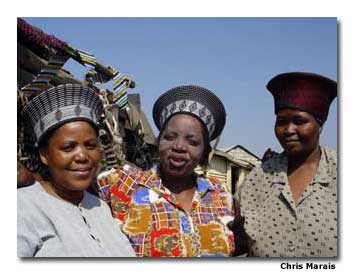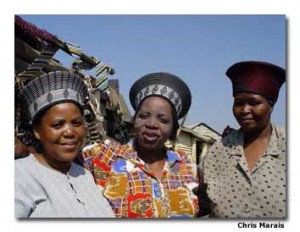

When Dave Charles was a small boy, his family moved from the city of Johannesburg to the countryside of Zululand and found him a nanny. His mother asked the Zulu woman if she spoke English.
“Yes,” she replied, and was hired on the spot. But “yes” was the only English word she knew, and so Dave Charles was raised in the Zulu vernacular. More than 40 years later, Dave knows that his love for one of the continent’s most intriguing cultures – unified by King Shaka in the early 1800s – and its language was a gift that few white South Africans ever receive.
He and his wife Sue moved to Zululand some years ago. Zululand or KwaZulu was one of the ten self-governing territories for different black ethnic groups (like the Xhosa, Ndebele or Zulu) within the “old” South Africa. These so called “Homelands” were established as part of the racial segregation policy of apartheid.
About 5.8 million people lived in Zululand, one of the larger territories. Ulundi was its capital. With the adoption of a democratic government, all Homelands ceased to exit on April 27, 2004, and were re-incorporated into modern South Africa as newly designated provinces. Today, Zululand is part of the province KwaZulu/Natal on the Indian Ocean. And the term Zululand is no longer political, but has a cultural meaning.
In Zululand, Sue opened “Ikon Afrika,” a décor and craft shop at “The Kingdom” near the picturesque town of Ballito, 30 miles (about 50 kilometres) north of Durban, a Zulu cultural centre located on an old sugar estate. And Dave ventured deep into Zululand to source authentic work.
But, following a trail of rumor, wood smoke and tradition, he came upon an astounding fact: the heart of true Zulu workmanship had moved to the Durban area, right under the sun-browned skin of this First World holiday city, known more for its beaches, high rise resorts and trendy nightclubs than for its Deep Zulu nature.
Nosing around Sue’s shop recently, I fell into a conversation with Dave about the cowhide shields and ceremonial spears on display.
“Look, if you’re interested, why don’t you come with me tomorrow?” he offered. “I’m going to see some craftsmen down Durban way.”
I accepted, little knowing I was to have the cultural experience of a lifetime.
When you drop off the coastal highway into KwaMashu, be prepared for a vast, technicolor township of millions that rivals the legendary Soweto in size and complexity. We drove, Dave and I, down ever-narrowing roads past mazes of mud shacks and wood huts, each connected to a spider’s web of overhead electric lines.
We passed a tumbledown strip mall of tuck shops, TV repair dens, shoe stalls, and a “steakhouse” where the barbecue fire had been lit and the cow awaited the chop. Eventually, we arrived at Bheki Biyela’s place, on the crest of a small hill.
If this were London, Bheki Biyela would have had a shingle out on Bond Street, saying “By Appointment to His Royal Majesty.” As a supplier of traditional garb to the Zulu Royal House, he is known to be one of the finest Zulu tailors in the country.
Outside his modest shack was a serval skin, stretched out on a rack. Inside Bheki’s place, there was a workroom, a bedroom – and little else. A stout Zulu man entered with the air of a regular customer and admired himself in a leopard skin mantle, usually reserved for royalty.
Three women who had seen our parked vehicle came by to show off their new “isixolos,” modern and lightweight versions of the wide red headdress worn by Zulu matrons.
Bheki displayed the striking new trend that has swept through the world of Zulu traditional garb: black and white suedette patterns with colored car reflectors inset, which is then worn with cat skin.
It’s tough on the local feline populations, but one gets the idea that “luiperdlap” (faux leopard skin) will never be a runaway item in this part of the world.
Along Musa Road in KwaMashu was a fruit stall festooned with dozens of fine bananas. I wanted a couple for breakfast, so we parked nearby. Out came the bubbling Petros Mkhwanazi, former boxing announcer for Radio Zulu and future guesthouse entrepreneur. Once Dave had done the introductions, Petros took us into his guest room, adorned with Zulu pin-up girls, local boxing greats, two dangling weaver’s nests and a row of ancient, crumbling South African banknotes.
“I know, I know”, he said, laughing. “I once buried that money to keep it safe.”
Into this tiny 2 x 3-m room (64 square feet), Petros had packed a world of comforts: a bed, a television set, a stove and a chair. The en-suite bathroom was basic, and I fear none but the bravest of travellers would book in at “Chez Mkhwanazi.”
However, I saw a tough overland writer like Paul Theroux dropping his pack here, settling in for a month and emerging with a best-selling “Inner Zulu” epic that would leave us South African writers shame-faced. And how much would Petros charge for a night at his place?
“Thirty Rands (US$ 4.50),” he said. “No, make that thirty five…”
We left KwaMashu and entered Durban from the north, passing fabric shops and the venerable Lion Match factory, stopping at the disused railway station in Umgeni Road. This is where Zulu women rule.
They’re mostly rural women weavers who trek in for a few weeks to sell their wares. They stay somewhere in the back of the building, and each morning they set up shop on the sidewalk, selling sleeping mats, black clay pots and Zulu cutlery. And they don’t haggle, as I soon found out.
“How much for this mat?” asked Dave, in his slow, amiable Zulu.
“Seventy Rands (US$ 10.50),” the seller replied.
“How about 60 Rands?”
“Seventy Rands.”
“Maybe 65?”
“Seventy Rands.”
“OK, then. We’ll take two.”
Dave Charles asked the women if they were safe here on Umgeni Road. Weren’t they worried that men would rob them?
“Let them come,” one of the women replied. “Then they will see what we do to them.”
Dave was looking for one James Bhengu, the best shield-maker in town. He works in a hostel near the docks, and during the 10 minutes we spent searching the building for him.
I felt extremely pale in a very dark world. But Dave’s language skill and easy manner relaxed everyone in the unlit corridors of this desperate place. James Bhengu was nowhere to be found.
We crossed over to the Dalton Road Skin Dealers, where it was a hive of industry. Zulu radio blared out from the stalls, which double as bedrooms and shops for the workmen inside. They were making spears, knobkerries, drums, shields and the entire array of traditional Zulu paraphernalia that you see the warriors wearing on TV at special occasions.
Here we found another Bhengu, a powerful, strong-featured man called Kay. He makes it all, from beautiful cowhide shields to nut-like objects worn at the end of a warrior’s penis – the “umncedo.” Dave provided a little light background:
“In the old days, a Zulu man could be considered fully dressed wearing only this little widget fitted onto his member. It is said that when King Shaka berated his advisors, all their umncedos would drop off at the same time.”
Our last stop of the morning was at the Victoria Street Muthi Market, a sprawling outdoor display on a bridge overpass with the Durban skyline in the background. This is the second economy of our country, Africa-to-Africa in full throttle.
More than 80 percent of all South Africans use traditional medicine at some time in their lives. Hundreds of metres of stalls were bunched up next to each other selling powders, roots, barks, shells, animal heads, skins of every description, sea beans, wings, feathers and other body parts – each with a specific medicinal purpose.
Dave was busy chatting with a woman about one of her potions. They were inspecting some “Zulu Viagra,” and it was a crowd-stopping passage involving ribald hand movements, raised eyebrows and much laughter. Everyone passing by had something to add to the conversation, and by the way they leered at me, I could see my old friend Dave was setting me up for a big sale.
I was right. The potions lady scooped together a package of twigs and fine brown powder into some newspaper wrapping and told me, via Mr Charles:
“One tablespoon if you’re brave, stirred into a glass of milk or a cup of soup. But make sure there’s a woman in your arms already, because this thing, it works fast…”
We finished off the tour with a seafood lunch at Splashes Restaurant, near the end of Point Road. By then, I had had the scales dropped from my eyes. After years of indigenous encounters around the world, from weekends in deepest Borneo with the erstwhile head-hunting Ibans, to throat-singing competitions in the middle of Mongolia’s Gobi Desert, I’d come upon a cultural product that has left me totally thrilled – and informed – at last.
And it was right here in South Africa – my own back yard. Over a second cold beer, I told Dave Charles as much.
“Oh,” he mused. “Do you really think people would like to come Zulu shopping with me?”
“Only the brave ones, Dave. And there’s quite a few of those.”
IF YOU GO
You can travel with Dave Charles to urban settlements around Durban in South Africa’s KwaZulu Natal Province to visit genuine Zulu shield makers, cobblers, spear makers and tailors of traditional Zulu apparel to find that particular piece you have always wanted.
Contact Dave Charles at Ikon Afrika
www.ikonafrika.co.za
Ballito Cultural Attractions
https://www.ballito.net/cultural.php
South Africa Tourism
https://www.southafrica.net
- Sailing Coastal Maine on a Historic Wooden Windjammer - July 11, 2024
- How to Make the Most of Two Days in Vienna - July 11, 2024
- Visiting Scotland? Don’t Miss These 5 Top Destinations - May 16, 2024

Could you please assist, i am looking for leopard skin hat, the one wearing by women for african methodist episcopal church its a uniform, the shape is round it is like indian cap